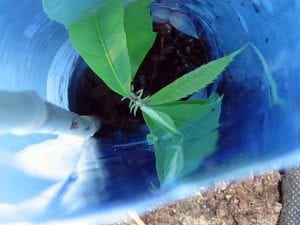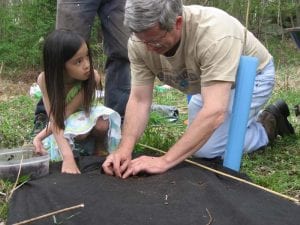 A view of a beautiful new American chestnut seedling emerging from its nut as viewed down a Bluex Tree Tube Shelter. Photographer Leila Pinchot [click on photo to see larger version]
A view of a beautiful new American chestnut seedling emerging from its nut as viewed down a Bluex Tree Tube Shelter. Photographer Leila Pinchot [click on photo to see larger version]
A group of dedicated individuals, representing the American Chestnut Foundation and the Guilford Conservation commission, gathered on behalf of the American Chestnut on Saturday, May 5th 2007 at Nut Plains Park. The group planted a test orchard, consisting of twenty hybrid chestnuts, to determine whether the site is suitable for a full orchard.

CT-TACF Member Brian Pistolese demonstrates nut planting technique. Photographer Leila Pinchot
On arrival, the participants found the parcel to have been lying fallow ever since the previous tenants, community gardeners, abandoned the property due to vandalism a few years ago. On the north end of the field, a line running NW to SE 120’ long by 6’ wide was cleared and mowed. Landscaping fabric was laid down with staples and twenty evenly spaced holes were dug and filled with a mixture of peat moss, water, and forest soil containing beneficial mychorrizae. A hybrid chestnut was carefully planted in each hole and protected from voles and deer with a tree shelter. Finally, a clothespin was fastened on each to keep out gobblin’ turkey. If the seedlings grow well, a complete breeding orchard, with about 300 trees, will be established on the site next spring.

